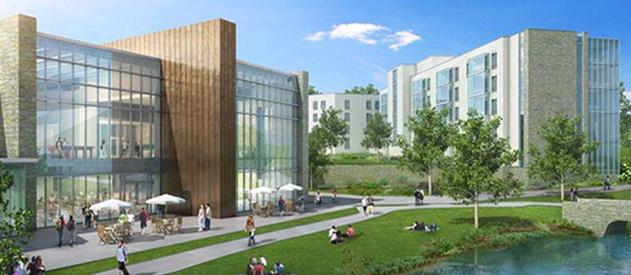Students have recently begun to express concern regarding the funding of the $118 million construction project taking place on the Pleasantville campus. The University’s Westchester locations suffered a loss of $9.6 million in the 2013 fiscal year, which slightly increased in the 2014 fiscal year. Both Pleasantville’s financial state and the high cost of the construction project raise a number of questions, which, until now, students have not been able to vocalize because this information was only shared with faculty and staff.
“I didn’t know about it, but it makes sense that that’s where the money is coming from,” said senior Taryn Shank, a student on the New York City campus majoring in International Management, reacting to rumors of the NYC campus’ surplus funding the construction.
Two aspects of the project have already been completed: updates to the Environmental Center and the Kessel Student Center, which houses the cafeteria and commuter lounges. Two fields will also be completed in the spring, as part of the athletics update.
The most significant part of the project, however, is the construction of two new dormitories. Thomas Brady, Finance and Planning Treasurer, spoke of the new buildings, stating, “Similar to New York City, there’s two new residential facilities being built in Pleasantville. Most of the Pleasantville project cost is through the residential facilities that are being constructed.”
The first of the two new facilities will open in the fall of 2015, and the second will open in the fall of 2016. Currently, there are roughly 550 dormitory beds in the Briarcliff dorm. After Briarcliff is sold, these will be replaced with fresh beds in the new dorms that are “much nicer and more expensive,” according to Brady. In addition to these replacement beds, 175 more will be added.
“What’s very important about this isn’t just the physical buildings—it is also the redesign of the campus. The center of campus where most of this is going on was previously roads and parking lots, now it’s going to be more residential and pedestrian friendly—less cars, nice green space—more of expectations you have when you go to a suburban campus,” Brady said.
Construction, which started one year ago, is set to wrap up in the summer of 2016.
In regard to construction costs in the midst of a grave financial situation, Brady is optimistic. He believes the construction will help dig Pleasantville out of their million dollar loss, because it will address what is believed to be one of the biggest reasons students decide not to attend the Westchester campus: decrepit, unwelcoming facilities.
According to Brady, the funds for this project come from three sources. The first is $100 million of bonds, which were issued in March 2014, and are the primary source of funding. The second is fundraising, which accounts for about $10 million. The third is the sale of Briarcliff, which has yet to happen.
It’s important that students on the New York City campus are cognizant of the fact that their tuition money is not going towards Pleasantville’s construction project, as some students have assumed. Brady noted that there are always many physical plant improvements happening, and that it is only those projects that are funded through tuition and fees.
“There are always smaller projects you see—whether it’s roof repairs or bathrooms being updated—those projects are being funded through tuition and fee revenues. But the Master Plan is a very specific project with a very specific funding source,” he said.
According to Brady, the debt is covering a big chunk of the plan currently, and some of it is being reimbursed—the fundraised money has not yet been obtained, but will be gathered by the time the construction is complete, he said.
When asked about the $9.6 million loss, Bob Almon, Chief Financial Officer and Executive Vice President said, “That’s a complicated subject.”
Almon attributes the loss to the University allocating overhead costs to both campuses. He also expressed concern over enrollment issues on the Pleasantville campus. If enrollment is low, there is not enough money to cover the costs of overhead and the many other expenses that come with running a campus. While enrollment on the New York City is thriving, enrollment on the Pleasantville’s campus has declined.
“It sort of ties directly into what the construction project is for. The project is supposed to reverse that by making the campus more attractive so that we can increase involvement. And to build the dorms—it turns out it’s not much more expensive to build new ones than it is to renovate old ones,” Almon said.
Vince Barrella, former New York Faculty Council Chairperson, who is also on the University Budget Committee and is a faculty representative to the Board of Trustees Finance Committee, weighed in on the topic, saying, “Obviously, enrollment is critical in closing any gap. It either becomes profitable or it continues to be an ongoing problem. On that end the faculty is unified—we all wish that Pleasantville was doing better.”
When asked if the construction would revive Pleasantville’s financial health and potentially reverse the large impact of the losses, Almon responded, “I wouldn’t say that because we’re not sure of that. It’s supposed to help, though.”
Pressed further for estimated income the construction would bring, Almon stated, “The estimate of the money it might bring are projections that were shared with the board,” he said, “it’s very hard to know if that will ever come true.”
Almon noted that the construction isn’t the only aspect that will help enrollment—there are academic issues that go along with it. He said this is an integrated project where new academic programs will be brought at the same time to make a difference.
In addition to construction updates, a faculty subcommittee was formed to offer further suggestions, which included selling Briarcliff (which was implemented), moving the Seidenberg School to the New York City campus where the tech sector is, and closing the Graduate Center, where enrollment has declined by 34 percent over the past eight years. These are, however, simply suggestions that remain in discussion.
Nancy Reagin, current New York Faculty Council Chairperson spoke of more concrete plans, stating, “…We’ll have to budget very carefully next year, but after that our financial situation should improve. The New York faculty expect that as Pleasantville’s operating losses diminish following completion of the construction, the profits generated by the New York campus will be reinvested back into the New York programs and campus, in order to support our continued growth.”
Shank, however, is skeptical of supplementing the Pleasantville campus, as she believes that the New York City campus deserves to thrive.
“The Pleasantville funding isn’t benefitting New York City students,” she said.
Acknowledging this fact, Barrella gave his final take on the situation with both hope and realism: “Could they be wrong? Yes. Do I hope they’re not wrong? I sure as hell hope they’re not wrong. As a University, given the previous decisions that have been made, it is critical that Pleasantville succeeds.”







